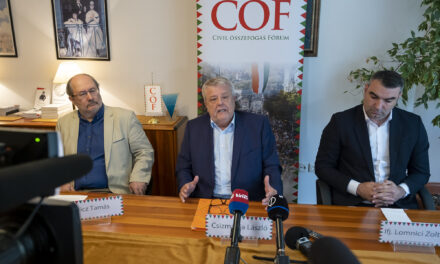Last Friday, even the deputy mayor Péter Pálinkás, the main organizer, probably didn't think how many people would gather at the 300-year-old St. Anne's Chapel the next day, helping to fix the building next to the shrine.
Today is a very nice day! - wrote the deputy mayor in his summary post on Saturday evening, expressing his joy.
Together in a good mood, we managed to concrete the small house in the chapel! Many people visited us, some brought cake, some scones, and there were those who supported us not only with their encouragement. We had delicious bean goulash for lunch.
According to Péter Pálinkás, what works on a small scale must also work on a city level.
If there is a goal that we feel is ours, we can achieve it selflessly as long as there are like-minded, determined people. Today showed that it is possible to build unselfishly, helpfully and unitedly. We said goodbye by continuing
he said.
On Saturday, our portal also visited the location, where more than a dozen people were hanging out. The concrete mixer was forgotten, the concrete iron sparkled under the disk of the flex, young and old wheelbarrowed the cement mixed with aggregate under the hands of the "pallér", Károly Sárosi. Of course, we also met people who are regular contributors to similar voluntary actions. Among them, Csaba Liptai, József Nagy, and last but not least, Petró Lajos "Bigin", who can be counted on not only as a civil guard or as an activist of various church and sports events, but soon also as a local government representative, since with the resignation of Péter Bera - who, as we wrote, became head of the ministry's department due to a conflict of interest due to his appointment, he returned his mandate - he is next in line on the election shortlist.
If they call, I'll come! - said Bigin, who even at the age of 70 and with "set in" muscles, turns the shovel in a way that many young people would envy. But not the 20-year-olds who were also present at its concreting, and "put themselves there" instead of spending their Saturday morning and afternoon - like many of their contemporaries - with well-deserved fallout.
Péter Pálinkás said: after the chapel and its surroundings were put in order in recent years – thanks in no small part to the successful tenders supported by the member of parliament Zsolt Szabó – he thought it would be good to create a community space from the former caretaker's house. In the summer, above all, the defects of the roof were repaired and the building was renovated externally, and this time the foundation was reinforced. Many people helped with their donations, so the weekend could end successfully. If the cooperation is similar next year, the interior can be completed, including the shower.
The beautification of the funeral procession and its surroundings can be linked to a significant date: the chapel was built in 1723, i.e. three hundred years ago this year, and consecrated in 1725.
The July holiday mass in honor of St. Anna, the grandmother of Jesus, was celebrated by Archbishop Csaba Ternyák of Eger. In the past, many pilgrims visited the farewell held on the banks of the Zagyva, and since the bicycle path was completed on the embankment of the river, many people once again visit the place of worship, praying or just relaxing in the beautiful and peaceful surroundings. Among other things, this encourages the deputy mayor to make the area even more comfortable if possible.
By the way, there are several legends about the construction of the chapel, which can be linked to the flood of Zagyva in 1722 and the cholera epidemic of 1723, and both events are probably related to the creation of the place of farewell.
According to one story, a brewer from Pest named Braxatoris was traveling with his cart towards the Highlands, but the water rushing down the flooded Zagyva spilled out and forced him to a small hill for days, where he vowed to build a chapel in fear. Based on other data, however, a master brewer named Král Vid built the chapel to commemorate the end of the plague epidemic in 1722. The third legend is about the son of a landowner in Zagyvaróna, who was boating on the Zagyva in a boat, and was then swept away by the river due to a sudden downpour. The child miraculously washed ashore alive near Lőrinci, where his father had a chapel built out of gratitude.
The small caretaker's house next to the main building - where the volunteers were now pouring concrete - housed a "hermit family" for a long time. Around the turn of the 1960s and 70s, the family was struck by a tragedy that shocked the entire neighborhood: their two little sons lost their lives in Zagyva. Later, the couple lived there for a while, and then the condition of the building began to deteriorate - until now.
Featured image: The weekend was full of work. In the foreground, Károly Sárosi, Péter Pálinkás and Lajos Petró are enjoying themselves / Ottó Tari/Heves Megyei Hírlap













